Abstract
Fibromyalgia syndrome is a major cause of chronic widespread pain and this affects 2.2% of all Koreans. Evidence exists for a genetic contribution to fibromyalgia. Those people who are predisposed to develop fibromyalgia may have this condition “triggered” by a variety of environmental “stressors,” including certain types of infections, physical trauma and catastrophic events. Some patients with fibromyalgia have been found to have abnormalities in a number of the body's “stress response” systems, including the hypothalamus-pituitary-adrenal axis and the autonomic nervous system. The most consistently detected objective abnormalities in fibromyalgia involve the pain-processing systems. Patients with fibromyalgia have displayed quantitative abnormalities in pain perception under experimental conditions. Fibromyalgia may be related to a decrease in the activity of the descending, antinociceptive pathways. In addition to neurobiologic mechanisms, psychologic and behavioral factors also play a role for many patients for the different symptoms they express. Diagnosing and treating these patients is especially challenging due to the limited knowledge of the etiology of this disease and the poor response to conventional pain treatments. Strict adherence to the ACR classification criteria in clinical practice is not required to effectively treat patients with fibromyalgia. The treatments of fibromyalgia should be targeted to the central pain and the neuropsychological symptoms. Current evidence advocates a multifaceted program that emphasizes patient education, medications for improving symptoms and aggressive use of exercise and cognitive-behavioral therapy to restore function.
References
1. Gran JT. The epidemiology of chronic generalized musculoskeletal pain. Best Pract Res Clin Rheumatol. 2003; 17:547–61.
2. Wolfe F, Smythe HA, Yunus MB, Bennett RM, Bombardier C, Goldenberg DL, et al. The American College of Rheumatology 1990 criteria for the classification of fibromyalgia. Report of the multicenter criteria committee. Arthritis Rheum. 1990; 33:160–72.
3. Nisenbaum R, Reyes M, Mawle AC, Reeves WC. Factor analysis of unexplained severe fatigue and interrelated symptoms: overlap with criteria for chronic fatigue syndrome. Am J Epidemiol. 1998; 148:72–7.

4. Clauw DJ. Fibromyalgia. In: Hochberg MC, Silman AJ, Smolen JS, Weinblatt ME, Weisman MH, eds. Rheumatology. 4th ed. p.701–11. New York, Mosby,. 2007.
5. Wolfe F, Ross K, Anderson J, Russell IJ. Aspects of fibromyalgia in the general population: sex, pain threshold, and fibromyalgia symptoms. J Rheumatol. 1995; 22:151–6.
6. Kim SH, Bae GR, Lim HS. Prevalence and risk factors of fibromyalgia syndrome and chronic widespread pain in two communities in Korea – First report in Korean. J Korean Rheumatism Assoc. 2006; 13:18–25.
7. Kim SH. Prevalence of chronic widespread pain and chronic fatigue syndrome in young Korean adults. J Musculoskelet Pain. 2008; 16:149–53.

8. Kim SH, Lee K, Lim HS. Prevalence of chronic widespread pain and chronic fatigue syndrome in Korean livestock raisers. J Occup Health. 2008; 50:525–8.

9. Makela M, Heliovaara M. Prevalence of primary fibromyalgia in the Finnish population. Br Med J. 1991; 303:216–9.

10. Leveille SG, Ling S, Hochberg MC, Resnick HE, Bandeen-Roche KJ, Won A, et al. Widespread musculoskeletal pain and the progression of disability in older disabled women. Ann Intern Med. 2001; 135:1038–46.

11. Andersson HI, Ejlertsson G, Leden I. Widespread musculoskeletal chronic pain associated with smoking: an epidemiological study in a general rural population. Scand J Rehab Med. 1998; 30:185–91.
12. Petzke F, Gracely RH, Park KM, Ambrose K, Clauw DJ. What do tender points measure? Influence of distress on 4 measures of tenderness. J Rheumatol. 2003; 30:567–74.
13. Dadabhoy D, Clauw DJ. The fibromyalgia syndrome. Klippel JH, Stone JH, Crofford LJ, White PH, editors. Primer on the rheumatic diseases. 13th ed.p.p. 87–93. New York: Springer;2007.
14. Katz RS, Wolfe F, Michaud K. Fibromyalgia diagnosis. A comparison of clinical, survey, and American College of Rheumatology criteria. Arthritis Rheum. 2006; 54:169–76.

15. Clauw DJ. Fibromyalgia: correcting the misconceptions. J Musculoskel Med. 2003; 20:467–72.
16. Arnold LM, Hudson JI, Hess EV, Ware AE, Fritz DA, Auchenbach MB, et al. Family study of fibromyalgia. Arthritis Rheum. 2004; 50:944–52.

17. Offenbaecher M, Bondy B, de Jonge S, Glatzeder K, Krüger M, Schoeps P, et al. Possible association of fibromyalgia with a polymorphism in the serotonin transporter gene regulatory region. Arthritis Rheum. 1999; 42:2482–8.

18. Gürsoy S, Erdal E, Herken H, Madenci E, Alaşehirli B, Erdal N. Significance of catechol-O-methyltransferase gene polymorphism in fibromyalgia syndrome. Rheumatol Int. 2003; 23:104–7.

19. Clauw DJ, Chrousos GP. Chronic pain and fatigue syndromes: overlapping clinical and neuroendocrine features and potential pathogenic mechanisms. Neuroimmunomodulation. 1997; 4:134–53.

20. Pillemer SR, Bradley LA, Crofford LJ, Moldofsky H, Chrousos GP. The neuroscience and endocrinology of fibromyalgia. Arthritis Rheum. 1997; 40:1928–39.

21. McLean SA, Williams DA, Harris RE, Kop WJ, Groner KH, Ambrose K, et al. Momentary relationship between cortisol secretion and symptoms in patients with fibromyalgia. Arthritis Rheum. 2005; 52:3660–9.

22. Mountz JM, Bradley LA, Modell JG, Alexander RW, Triana-Alexander M, Aaron LA, et al. Fibromyalgia in women: abnormalities of regional cerebral blood flow in the thalamus and the caudate nucleus are associated with low pain threshold levels. Arthritis Rheum. 1995; 38:926–38.
23. Arroyo JF, Cohen ML. Abnormal responses to electrocutaneous stimulation in fibromyalgia. J Rheumatol. 1993; 20:1925–31.
24. Gracely RH, Petzke F, Wolf JM, Clauw DJ. Functional magnetic resonance imaging evidence of augmented pain processing in fibromyalgia. Arthritis Rheum. 2002; 46:1333–43.

25. Desmeules JA, Cedraschi C, Rapiti E, Baumgartner E, Finckh A, Cohen P, et al. Neurophysiologic evidence for a central sensitization in patients with fibromyalgia. Arthritis Rheum. 2003; 48:1420–9.

26. Cook DB, Lange G, Ciccone DS, Liu WC, Steffener J, Natelson BH. Functional imaging of pain in patients with primary fibromyalgia. J Rheumatol. 2004; 31:364–78.
27. Kuchinad A, Schweinhardt P, Seminowicz DA, Wood PB, Chizh BA, Bushnell MC. Accelerated brain gray matter loss in fibromyalgia patients: premature aging of the brain? J Neurosci. 2007; 27:4004–7.

28. Lutz J, Jäger L, de Quervain D, Krauseneck T, Padberg F, Wichnalek M, et al. White and gray matter abnormalities in the brain of patients with fibromyalgia: a diffusion-tensor and volumetric imaging study. Arthritis Rheum. 2008; 58:3960–9.

29. Russell IJ, Orr MD, Littman B, Vipraio GA, Alboukrek D, Michalek JE, et al. Elevated cerebrospinal fluid levels of substance P in patients with the fibromyalgia syndrome. Arthritis Rheum. 1994; 37:1593–601.

30. Sarchielli P, Alberti A, Floridi A, Gallai V. Levels of nerve growth factor in cerebrospinal fluid of chronic daily headache patients. Neurology. 2001; 57:132–4.

31. Alpar EK, Onuoha G, Killampalli VV, Waters R. Management of chronic pain in whiplash injury. J Bone Joint Surg Br. 2002; 84:807–11.

32. Harris RE, Sundgren PC, Pang Y, Hsu M, Petrou M, Kim SH, et al. Dynamic levels of glutamate within the insula are associated with improvements in multiple pain domains in fibromyalgia. Arthritis Rheum. 2008; 58:903–7.

33. Kosek E, Ekholm J, Hansson P. Sensory dysfunction in fibromyalgia patients with implications for pathogenic mechanisms. Pain. 1996; 68:375–83.

34. Julien N, Goffaux P, Arsenault P, Marchand S. Widespread pain in fibromyalgia is related to a deficit of endogenous pain inhibition. Pain. 2005; 114:295–302.

35. Vaeroy H, Nyberg F, Terenius L. No evidence for endorphin deficiency in fibromyalgia following investigation of cerebrospinal fluid (CSF) dynorphin A and Met-enkephalin-Arg6-Phe7. Pain. 1991; 46:139–43.
36. Russell IJ, Vaeroy H, Javors M, Nyberg F. Cerebrospinal fluid biogenic amine metabolites in fibromya-lgia/fibrositis syndrome and rheumatoid arthritis. Arthritis Rheum. 1992; 35:550–6.

37. Abeles AM, Pillinger MH, Solitar BM, Abeles M. Narrative review: the pathophysiology of fibromyalgia. Ann Intern Med. 2007; 146:726–34.

38. Gronemann ST, Ribel-Madsen S, Bartels EM, Danneskiold-Samsoe B, Bliddal H. Collagen and muscle pathology in fibromyalgia patients. Rheumatology (Oxford). 2004; 43:27–31.

39. Sprott H, Salemi S, Gay RE, Bradley LA, Alarcón GS, Oh SJ, et al. Increased DNA fragmentation and ultrastructural changes in fibromyalgic muscle fibres. Ann Rheum Dis. 2004; 63:245–51.

40. Ribel-Madsen S, Gronemann ST, Bartels EM, Danneskiold-Sams⊘e B, Bliddal H. Collagen structure in skin from fibromyalgia patients. Int J Tissue React. 2005; 27:75–82.
41. Kim SH, Jang TJ, Moon IS. Increased expression of N-methyl-D-aspartate receptor subunit 2D in the skin of patients with fibromyalgia. J Rheumatol. 2006; 33:785–8.
42. Kim SH, Kim DH, Oh DH, Clauw DJ. Characteristic electron microscopic findings in skin of patients with fibromyalgia. Clin Rheumatol. 2008; 27:407–11.
43. Kim SH. Skin biopsy findings: implications for the pathophysiology of fibromyalgia. Med Hypotheses. 2007; 69:141–4.

44. Alvarez Lario B, Alonso Valdivielso JL, Alegre López J, Martel Soteres C, Viejo Bañuelos JL, Marañón Cabello A. Fibromyalgia syndrome: overnight falls in arterial oxygen saturation. Am J Med. 1996; 101:54–60.
45. Altindag O, Celik H. Total antioxidant capacity and the severity of the pain in patients with fibromyalgia. Redox Rep. 2006; 11:131–5.

46. Kim SH, Moon IS. Hypoxia – a possibility in fibromyalgia syndrome pathogenesis? J Korean Rheumatism Assoc. 2006; 13:218–25.
47. White KP, Nielson WR, Harth M, Ostbye T, Speechley M. Chronic widespread musculoskeletal pain with or without fibromyalgia: psychological distress in a representative community adult sample. J Rheumatol. 2002; 29:588–94.
48. McBeth J, Macfarlane GJ, Hunt IM, Silman AJ. Risk factors for persistent chronic widespread pain: a community-based study. Rheumatology (Oxford). 2001; 40:95–101.

49. Gracely RH, Geisser ME, Giesecke T, Grant MA, Petzke F, Williams DA, et al. Pain catastrophizing and neural responses to pain among persons with fibromyalgia. Brain. 2004; 127:835–43.

50. Giesecke T, Williams DA, Harris RE, Cupps TR, Tian X, Tian TX, et al. Subgrouping of fibromyalgia patients on the basis of pressure-pain thresholds and psychological factors. Arthritis Rheum. 2003; 48:2916–22.

51. Dadabhoy D, Crofford LJ, Spaeth M, Russell IJ, Clauw DJ. Biology and therapy of fibromyalgia. Evidence-based biomarkers for fibromyalgia syndrome. Arthritis Res Ther. 2008; 10:211.

52. Goldenberg DL, Burckhardt C, Crofford L. Management of fibromyalgia syndrome. JAMA. 2004; 292:2388–95.

53. White KP, Nielson WR, Harth M, Ostbye T, Speechley M. Does the label "fibromyalgia" alter health status, function, and health service utilization? A prospective, within-group comparison in a community cohort of adults with chronic widespread pain. Arthritis Rheum. 2002; 47:260–5.

54. Kranzler JD, Gendreau JF, Rao SG. The psychopharmacology of fibromyalgia: a drug development perspective. Psychopharmacol Bull. 2002; 36:165–213.
55. Bennett RM. Pharmacological treatment of fibromyalgia. J Funct Syn. 2001; 1:79–92.
56. Nishishinya B, Urrútia G, Walitt B, Rodriguez A, Bonfill X, Alegre C, et al. Amitriptyline in the treatment of fibromyalgia: a systematic review of its efficacy. Rheumatology (Oxford). 2008; 47:1741–6.

57. Capaci K, Hepguler S. Comparison of the effects of amitriptyline and paroxetine in the treatment of fibromyalgia syndrome. Pain Clin. 2002; 14:223–8.
58. Anderberg UM, Marteinsdottir I, Von Knorring L. Citalopram in patients with fibromyalgia: a randomized, double-blind, placebocontrolled study. Eur J Pain. 2000; 4:27–35.

59. N⊘rregaard J, Volkmann H, Danneskiold-Sams⊘e B. A randomized, controlled trial of citalopram in the treatment of fibromyalgia. Pain. 1995; 61:445–9.
60. Mattia C, Paoletti F, Coluzzi F, Boanelli A. New antidepressants in the treatment of neuropathic pain: a review. Minerva Anestesiol. 2002; 68:105–14.
61. Adelman LC, Adelman JU, Von Seggern R, Mannix LK. Venlafaxine extended release (XR) for the prophylaxis of migraine and tension-type headache: a retrospective study in a clinical setting. Headache. 2000; 40:572–80.

62. Harvey AT, Rudolph RL, Preskorn SH. Evidence of the dual mechanisms of action of venlafaxine. Arch Gen Psychiatry. 2000; 57:503–9.

63. Vitton O, Gendreau M, Gendreau J, Kranzler J, Rao SG. A double-blind, placebocontrolled trial of milnacipran in the treatment of fibromyalgia. Hum Psychopharmacol. 2004; 19(Suppl 1):27–35S.

64. Gendreau RM, Thorn MD, Gendreau JF, Kranzler JD, Ribeiro S, Gracely RH, et al. Efficacy of milnacipran in patients with fibromyalgia. J Rheumatol. 2005; 32:1975–85.
65. Clauw DJ, Mease P, Palmer RH, Gendreau RM, Wang Y. Milnacipran for the treatment of fibromyalgia in adults: a 15-week, multicenter, randomized, double-blind, placebocontrolled, multiple-dose clinical trial. Clin Ther. 2008; 30:1988–2004.

66. Mease PJ, Clauw DJ, Gendreau RM, Rao SG, Kranzler J, Chen W, et al. The efficacy and safety of milnacipran for treatment of fibromyalgia. A randomized, double-blind, placebocontrolled trial. J Rheumatol. 2009; 36:398–409.

67. Arnold LM, Lu Y, Crofford LJ, Wohlreich M, Detke MJ, Iyengar S, et al. A double-blind, multicenter trial comparing duloxetine with placebo in the treatment of fibromyalgia patients with or without major depressive disorder. Arthritis Rheum. 2004; 50:2974–84.

68. Arnold LM, Rosen A, Pritchett YL, D'Souza DN, Goldstein DJ, Iyengar S, et al. A randomized, double-blind, placebocontrolled trial of duloxetine in the treatment of women with fibromyalgia with or without major depressive disorder. Pain. 2005; 119:5–15.

69. Russell IJ, Mease PJ, Smith TR, Kajdasz DK, Wohlreich MM, Detke MJ, et al. Efficacy and safety of duloxetine for treatment of fibromyalgia in patients with or without major depressive disorder: results from a 6-month, randomized, double-blind, placebocontrolled, fixed-dose trial. Pain. 2008; 136:432–44.
70. Wiffen P, Collins S, McQuay H, Carroll D, Jadad A, Moore A. Anticonvulsant drugs for acute and chronic pain. Cochrane Database Syst Rev. 2005; 3:CD001133.

71. Crofford LJ, Rowbotham MC, Mease PJ, Russell IJ, Dworkin RH, Corbin AE, et al. Pregabalin for the treatment of fibromyalgia syndrome: results of a randomized, double-blind, placebocontrolled trial. Arthritis Rheum. 2005; 52:1264–73.

72. Mease PJ, Russell IJ, Arnold LM, Florian H, Young JP Jr, Martin SA, et al. A randomized, double-blind, placebocontrolled, phase III trial of pregabalin in the treatment of patients with fibromyalgia. J Rheumatol. 2008; 35:502–14.
73. Crofford LJ, Mease PJ, Simpson SL, Young JP Jr, Martin SA, Haig GM, et al. Fibromyalgia relapse evaluation and efficacy for durability of meaningful relief (FREEDOM): a 6-month, double-blind, placebocontrolled trial with pregabalin. Pain. 2008; 136:419–31.

74. Arnold LM, Russell IJ, Diri EW, Duan WR, Young JP Jr, Sharma U, et al. A 14-week, randomized, double-blinded, placebocontrolled monotherapy trial of pregabalin in patients with fibromyalgia. J Pain. 2008; 9:792–805.

75. Redillas C, Solomon S. Prophylactic pharmacological treatment of chronic daily headache. Headache. 2000; 40:83–102.

76. Arnold LM, Goldenberg DL, Stanford SB, Lalonde JK, Sandhu HS, Keck PE Jr, et al. Gabapentin in the treatment of fibromyalgia: a randomized, double-blind, placebocontrolled, multicenter trial. Arthritis Rheum. 2007; 56:1336–44.

78. Hannonen P, Malminiemi K, Yli-Kerttula U, Isomeri R, Roponen P. A randomized, double-blind, placebocontrolled study of moclobemide and amitriptyline in the treatment of fibromyalgia in females without psychiatric disorder. Br J Rheumatol. 1998; 37:1279–86.

79. Krishnan KR, France RD, Pelton S, McCann UD, Davidson J, Urban BJ. Chronic pain and depression. II: symptoms of anxiety in chronic low back pain patients and their relationship to subtypes of depression. Pain. 1985; 22:289–94.

80. Lautenschlager J. Present state of medication therapy in fibromyalgia syndrome. Scand J Rheumatol. 2000; 113(Suppl):32–6S.
81. Russell IJ, Perkins AT, Michalek JE, the Oxybate SXB-26 Fibromyalgia Syndrome Study Group. Sodium oxybate relieves pain and improves function in fibromyalgia syndrome. A randomized, double-blind, placebocontrolled, multicenter clinical trial. Arthritis Rheum. 2009; 60:299–309.
82. Holman AJ, Myers RR. A randomized, double-blind, placebocontrolled trial of pramipexole, a dopamine agonist, in patients with fibromyalgia receiving concomitant medications. Arthritis Rheum. 2005; 52:2495–505.

83. Russell IJ, Michalek J, Xiao Y. Therapy with a central alpha 2-adrenergic agonist (tizanidine) decreases cerebrospinal fluid substance P, and may reduce serum hyaluronic acid as it improves the clinical symptoms of the fibromyalgia syndrome. Arthritis Rheum. 2002; 46(Suppl):614S.
84. Harris RE, Clauw DJ, Scott DJ, McLean SA, Gracely RH, Zubieta JK. Decreased central mu-opioid receptor availability in fibromyalgia. J Neurosci. 2007; 27:10000–6.
85. Russell IJ. Fibromyalgia syndrome: approach to management. CNS Spectr. 2008; 13(Suppl 5):27–33S.

86. Clauw DJ. Pharmacotherapy for patients with fibromyalgia. J Clin Psychiatry. 2008; 69(Suppl 2):25–9S.
87. Goldenberg DL, Felson DT, Dinerman H. A randomized, controlled trial of amitriptyline and naproxen in the treatment of patients with fibromyalgia. Arthritis Rheum. 1986; 29:1371–7.

88. Goldenberg D, Mayskiy M, Mossey C, Ruthazer R, Schmid C. A randomized, double-blind crossover trial of fluoxetine and amitriptyline in the treatment of fibromyalgia. Arthritis Rheum. 1996; 39:1852–9.

89. Ozerbil O, Okudan N, Gokbel H, Levendoglu F. Comparison of the effects of two antidepressants on exercise performance of the female patients with fibromyalgia. Clin Rheumatol. 2006; 25:495–7.

90. Sluka KA, Kalra A, Moore SA. Unilateral intramuscular injections of acidic saline produce a bilateral, long-lasting hyperalgesia. Muscle Nerve. 2001; 24:37–46.

91. Harte SE, Kim SH, Clauw DJ, Morrow TJ. Altered regional cerebral blood flow at rest in an animal model of fibromyalgia. Arthritis Rheum. 2007; 56(Suppl):92S.
92. Kim SH, Lee J. Altered pain-associated molecules in the brain of an animal model of fibromyalgia – preliminary data. Ann Rheum Dis. 2008; 67(Suppl):254S.
93. Kim SH, Choi NH, Park IS, Nam KS. Serotonin changes in specific brain regions of fibromyalgia animal model after deep-sea water drinking. J Korean Rheumatism Assoc. 2008; 15:110–7.

94. Kim SH, Song J, Mun H, Park KU. Effect of the combined use of tramadol and milnacipran on the pain threshold in fibromyalgia animal model. Korean J Intern Med. In press. 2009.
95. Williams DA, Cary MA, Groner KH, Chaplin W, Glazer LJ, Rodriguez AM, et al. Improving physical functional status in patients with fibromyalgia: a brief cognitive behavioral intervention. J Rheumatol. 2002; 29:1280–6.
96. National Institutes of Health. Integration of behavioral and relaxation approaches into the treatment of chronic pain and insomnia. NIH Technology Assessment Panel on Integration of Behavioral and Relaxation Approaches into the Treatment of Chronic Pain and Insomnia. JAMA. 1996; 276:313–8.
Fig. 2.
Regional or localized syndromes that overlap with fibromyalgia for thier prevalence, mechanisms and treatment (4).
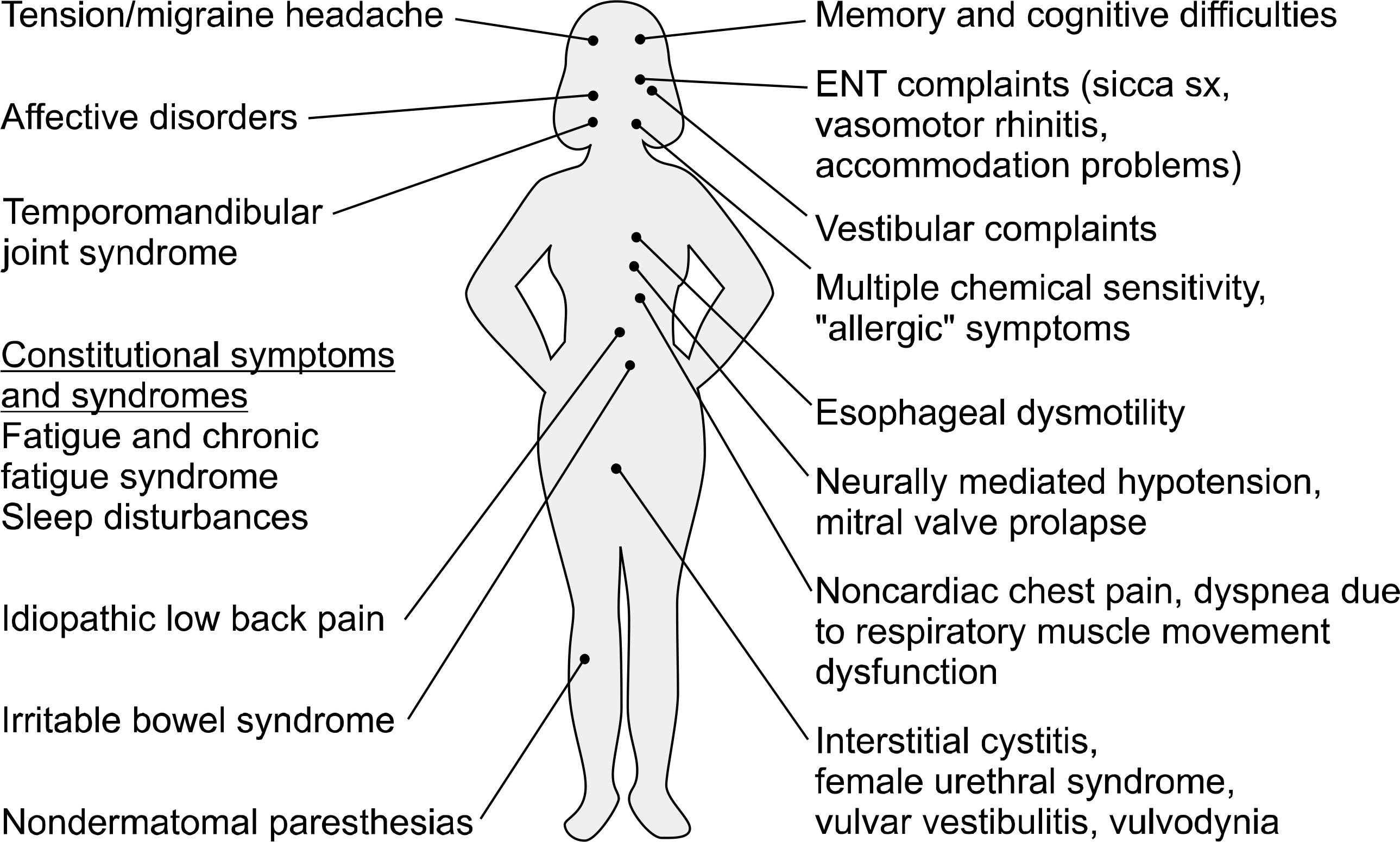
Fig. 3.
The functional magnetic resonance imaging (fMRI) responses to painful pressure applied to the left thumb in patients with fibromyalgia and in healthy control subjects. In the top left panel, the individuals with fibromyalgia (▲) and who were given a low pressure stimulus have similar levels of pain and neuronal activation in areas of the brain that are known to be involved in pain processing (ends of arrows) as the controls, and the controls were given nearly twice as much pressure. The controls, when given the same low pressure that caused pain in the fibromyalgia patients, they rated their pain as 2/20 instead of 12/20, and they show no neuronal activation with this amount of pressure (24).

Fig. 4.
Subgroups of fibromyalgia patients based on grouping by psychological, cognitive and neurobiological (the degree of hyperalgesia) factors (50).
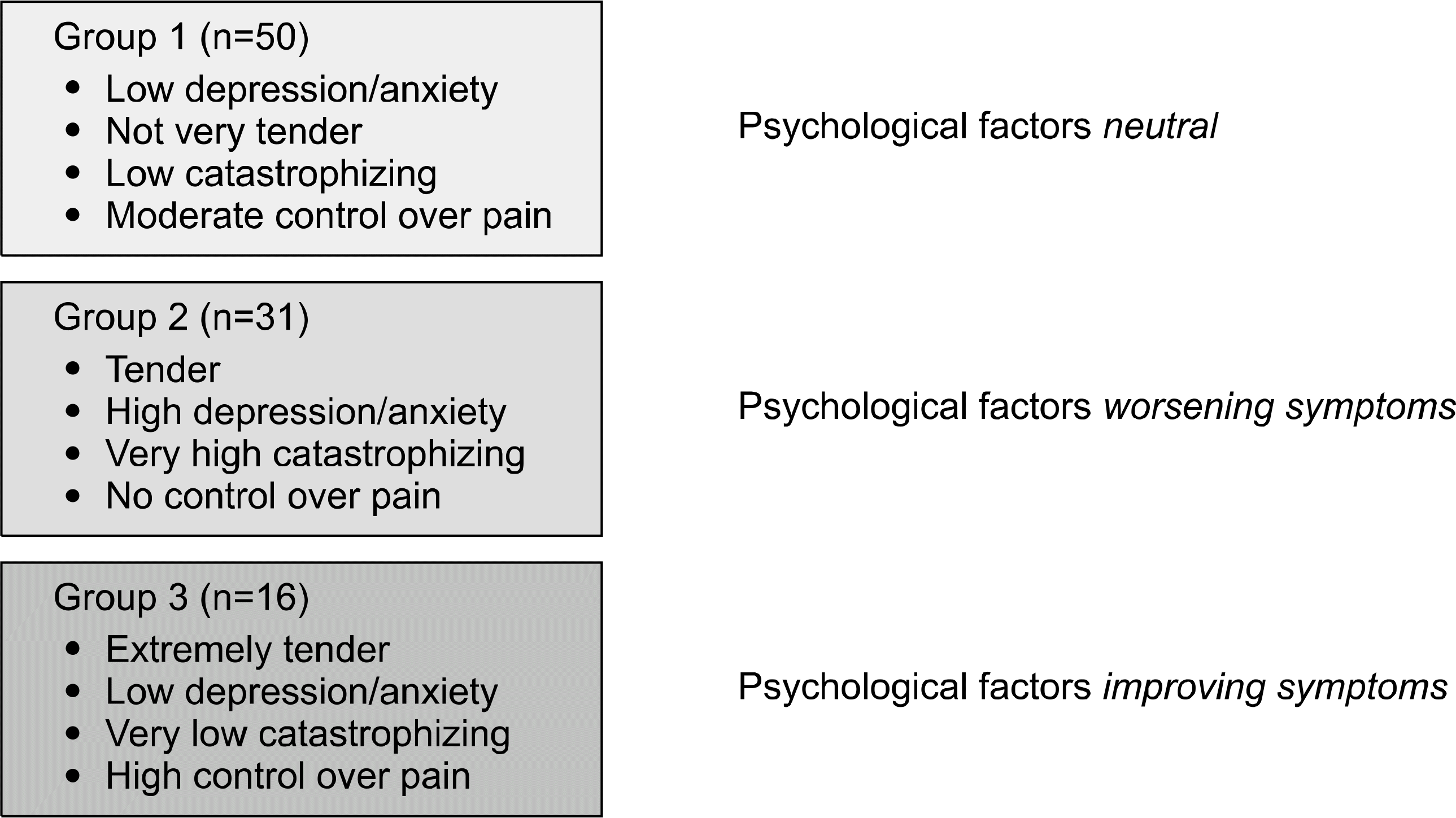
Fig. 5.
Strategic polypharmacy for a fibromyalgia patient with three prominent domains (pain, insomnia and depression). The combined use of either pregabalin or oxybate along with duloxetine could be considered because their mechanisms of action and elimination are quite different. Since there is very little research data and experience with such a regimen, it must be tailored to the individual patient and the patient must be carefully monitored (85).
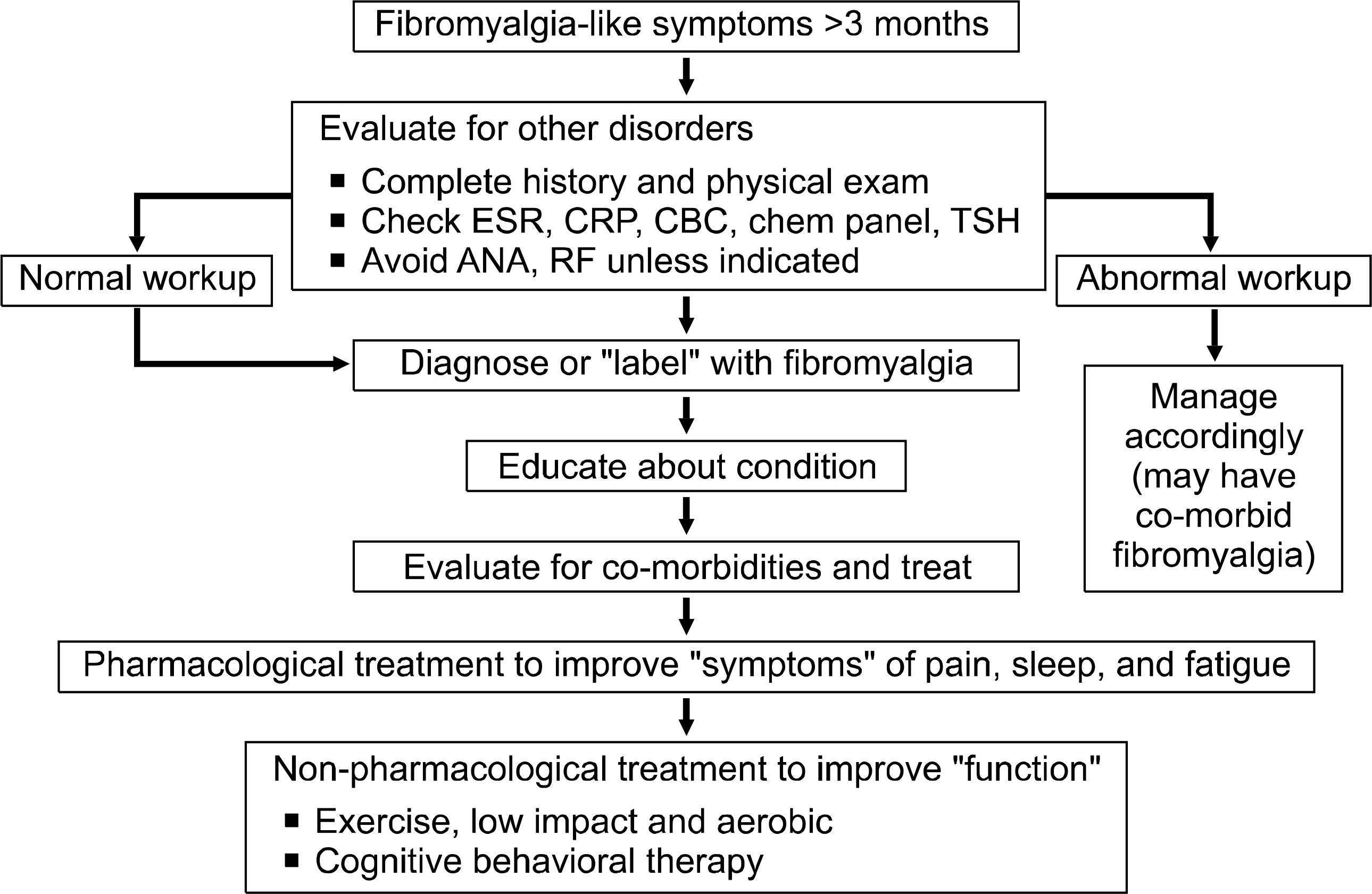
Table 1.
Pharmacologic treatments of fibromyalgia




 PDF
PDF ePub
ePub Citation
Citation Print
Print


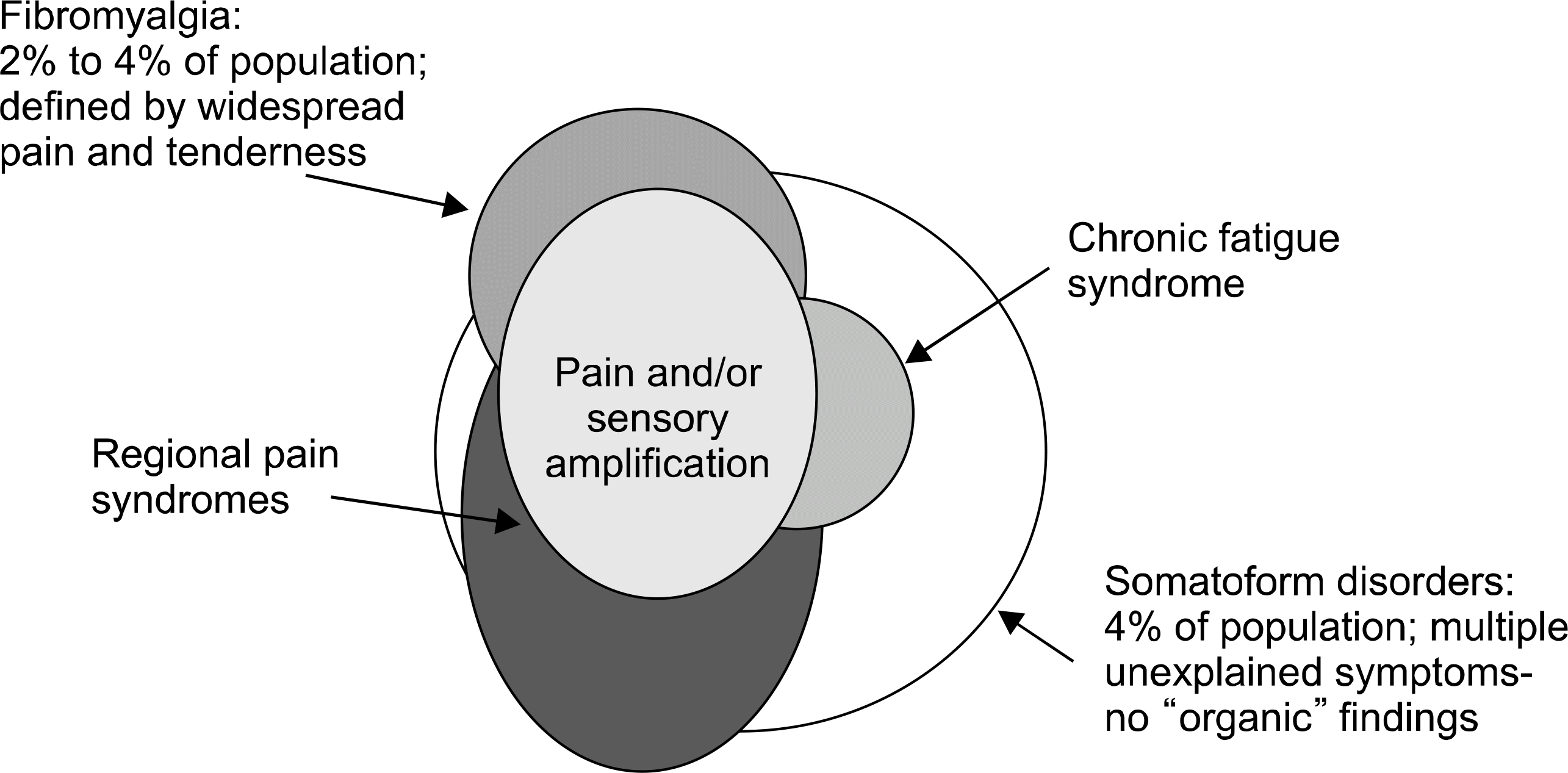
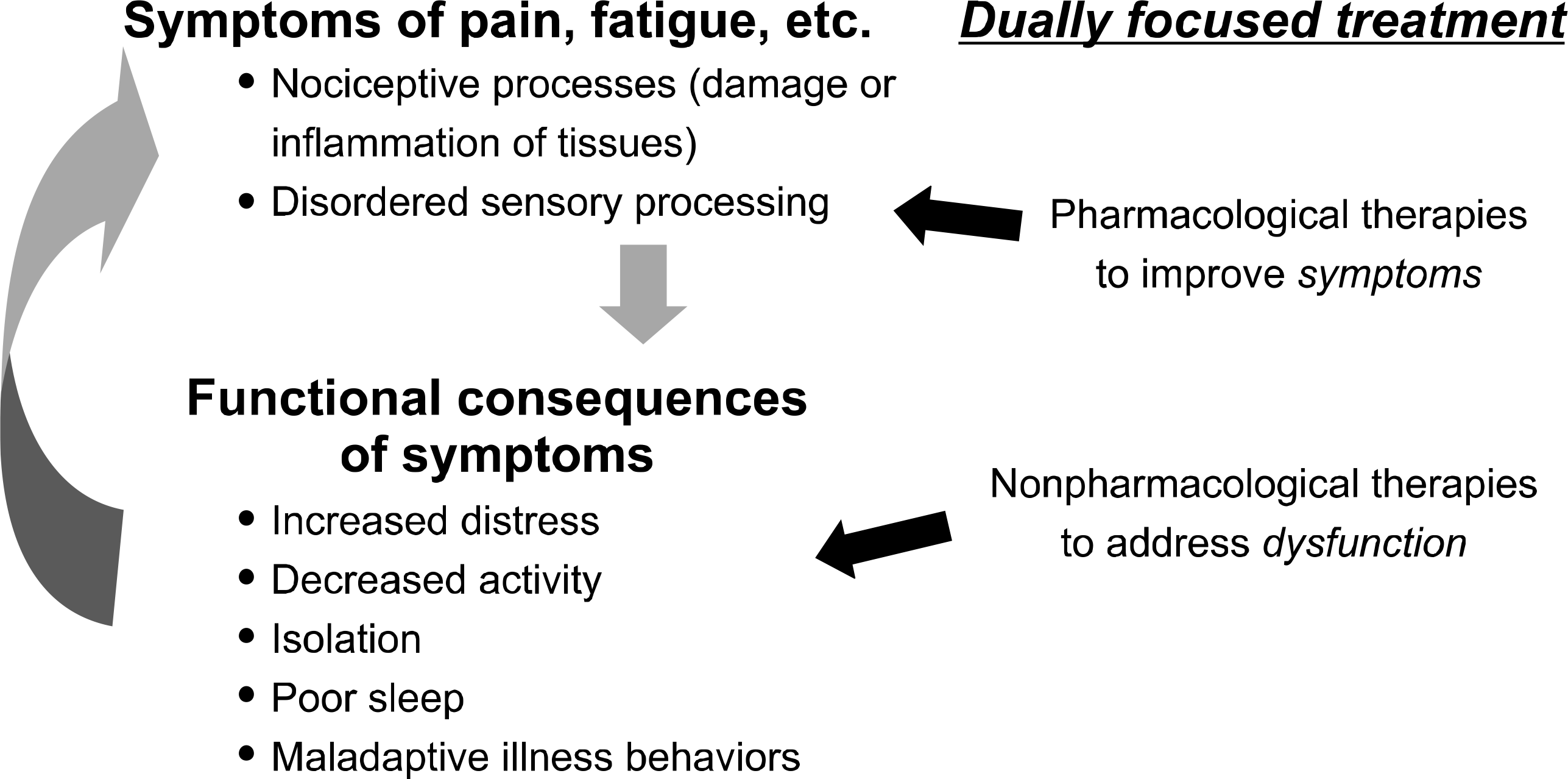
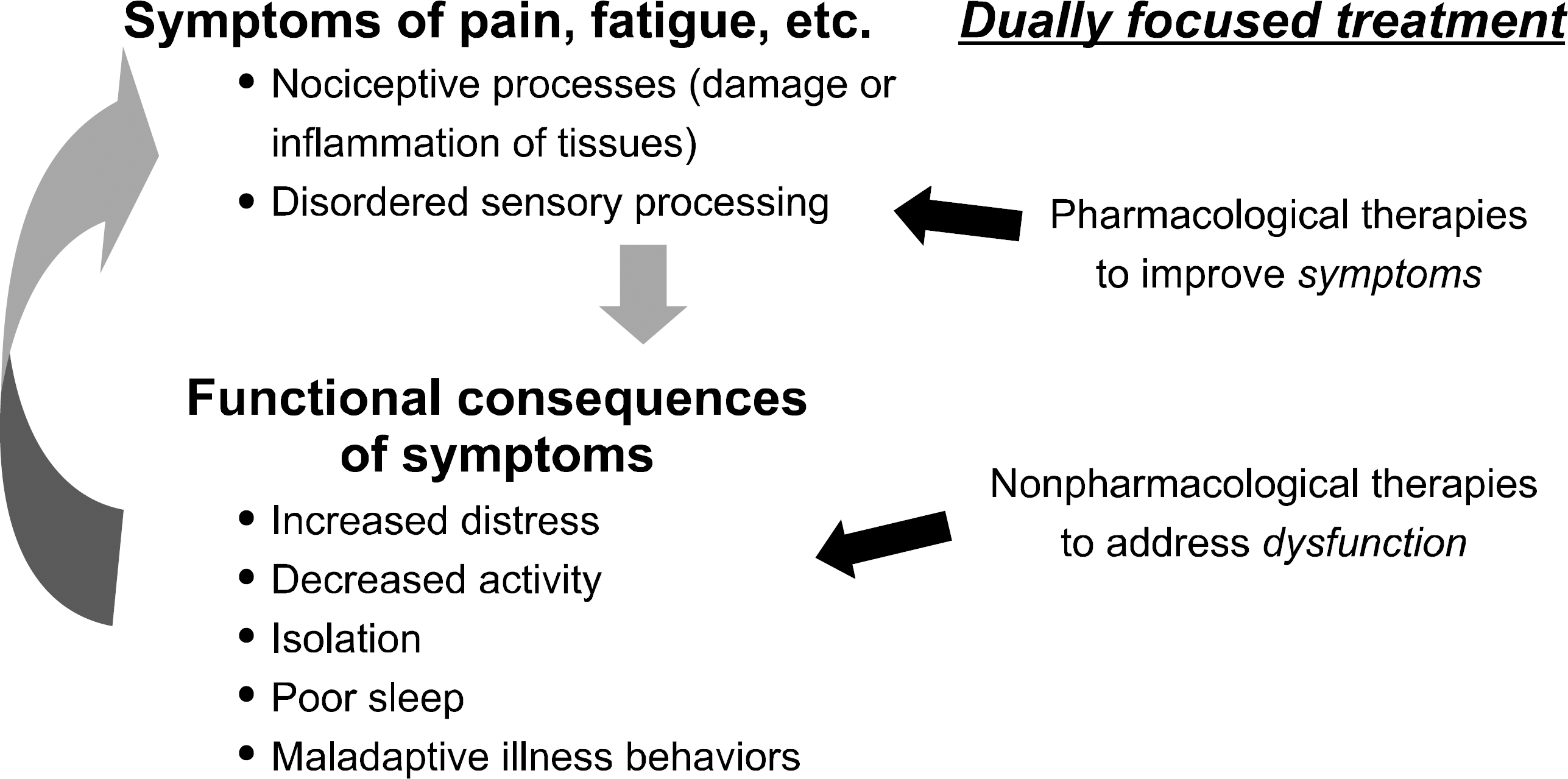
 XML Download
XML Download